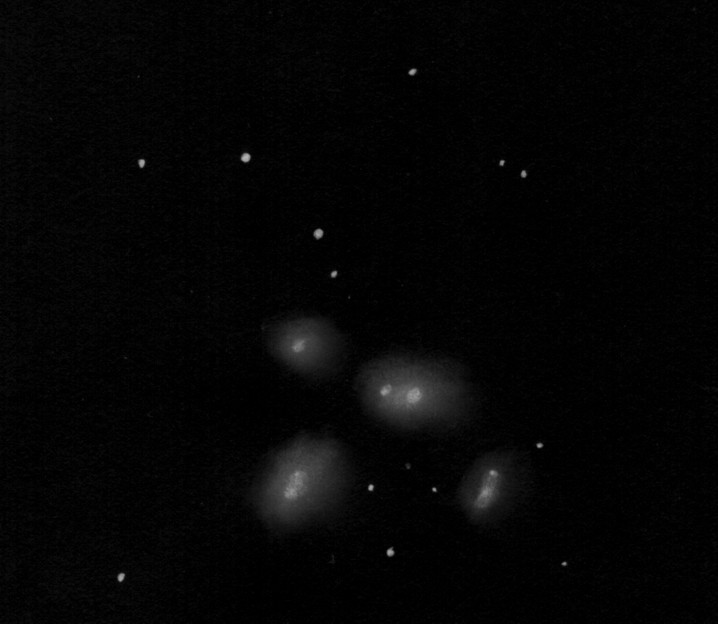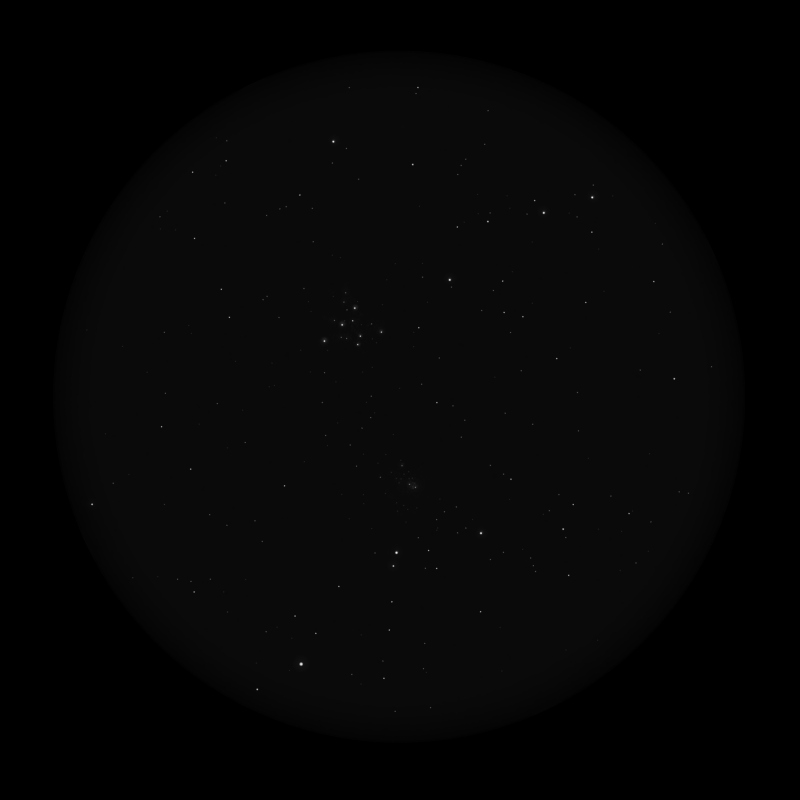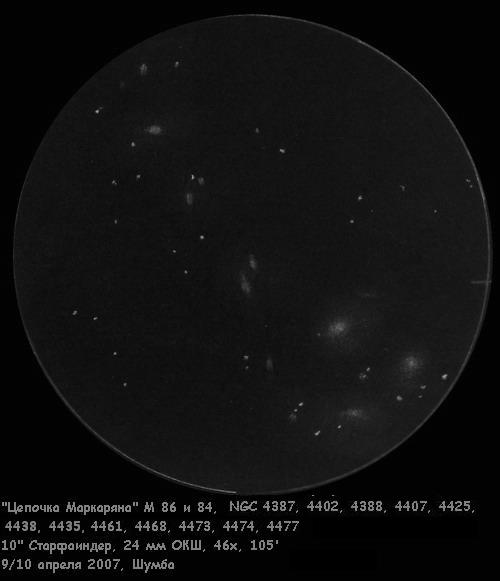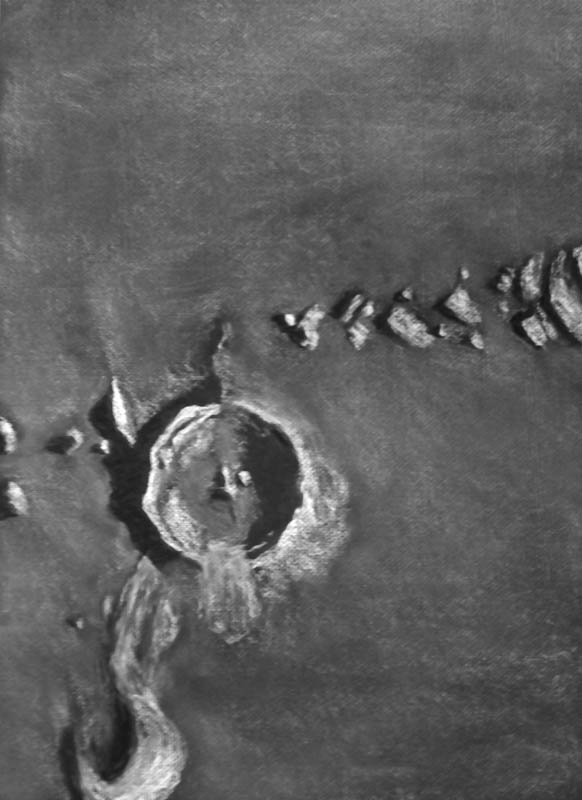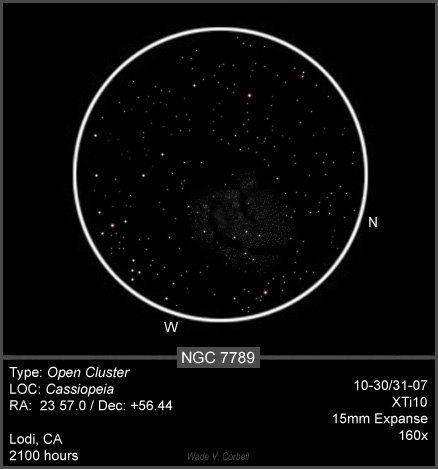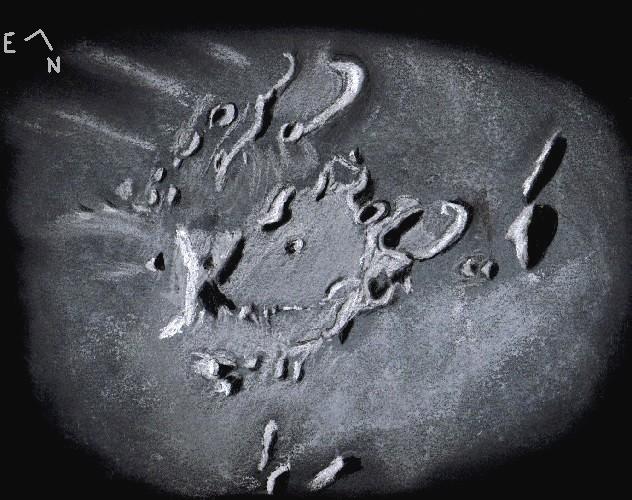Hickson 92 (Arp 319 / Stephan’s Quintet)
Sketch by Eiji Kato
Ray Crater Proclus at High Sun
Ray Crater Proclus
Sketch and Details by Frank McCabe
Bright rayed crater Proclus (28 km.) lies between the highland Marsh of Sleep (Palus Somni) and the lowland Sea of Crisis (Mare Crisium). Proclus is a young crater about the same age as large crater Copernicus. But unlike Copernicus, the Proclus impact event arrived at an angle less than 15° from the west southwest based on the butterfly wing pattern of debris seen on the lunar surface. This pattern can be seen again on the eastern side of the moon several hundred kilometers to the south of Proclus with craters Messier and Messier A (not drawn here). The gray area to the upper right of Proclus is Palus Somni inside the “forbidden zone” where no rays can occur in the uprange direction. See chapter 10 of “The Modern Moon” by Charles Wood, Sky Publishing Corporation, for a more complete explanation. The rim of this crater in the high sunlight was as brightly illuminated as the rays. This crater is nearly as bright as larger Aristarchus across the lunar nearside to the west. Like crater Tycho this is one of those craters that are most impressive at high sun even with a modest size telescope. More than a lifetime of observing and even sketching awaits the amateur astronomer on moonlit nights.
Sketching
For this sketch I used: black Strathmore 400 Artagain paper 12”x8”, white and black Conte’ pastel pencils and a blending stump. After scanning, Brightness was decreased (-6) and contrast increased (+5) using Microsoft Office Picture Manager.
Telescope: 10 inch f/ 5.7 Dobsonian and 6 mm eyepiece 241 x
Date: 7-16-2008, 4:20-5:45 UT
Temperature: 25° C (76° F)
Clear, light winds
Seeing: Antoniadi III
Colongitude 67.6°
Lunation 13 days
Illumination 95.8 %
Frank McCabe
Line of Sight Neighbors
M39 and NGC 7082
Sketch and Details by Rony De Laet
The brightest open cluster of Cygnus is Messier 39. With a diameter of more than a full moon, M39 is a beautiful binocular object. To find this open cluster, just drawn an imaginary line from Deneb (Alpha Cygni) to Alpha Lacerta and point your binoculars at the middle of that line. There you’ll find M39 as a large triangular configuration of 6 brighter stars with a dozen fainter ones. While you have this open cluster in your sight, try to find a neighbour of M39: NGC 7082, at one and a half degree to the south. NGC 7082 is rather dim, compared to M39. My binoculars show only a few faint stars in an elongated misty patch of weak unresolved star glow. M39 and NGC 7082 appear to be close companions, but this an optical illusion. While M39 is 830 light-years from us, NGC 7082 is about 5 times further away. With both objects in the field of view, it is not difficult to imagine that NGC 7082 floats far behind M39 through the night sky.
Site : Bütgenbach, Belgium
Date : July 1, 2008
Time : around 23.45 UT
Binoculars : Bresser 8×56
FOV: 5.9°
Filter : none
Mount : Trico Machine Sky Window
Seeing : 3,5/5
Transp. : 4/5
Nelm : around 5.8
Sketch Orientation : N up, W right.
Digital sketch made with Photo Paint, based on a raw pencil sketch.
(Note: if the sketch does look too dark on your monitor, try to darken the room.)
Galactic Queue
Markarian’s Chain
Sketch and Details by Ernest Shekolyan
Hi!
Let me contribute to ASOD one of my pictures
That is Markarian`s chain as it was seen 9/10 apr. 2007 in eyepiece of my scope at village Shumba, 50 km from St.Petersburg, Russia. That was visual limit 6.2m.
10″ Starfinder, 24 mm UWA, 46x, FOV: 105 ang. minutes, graphite pencil, white paper, then photocopy + level correction, crop and inverting in ACDSee
Sincerely yours, Ernest Shekolyan
Exquisite Eratosthenes
Eratosthenes and environs
Sketch and Details by Richard Handy
Description: Eratosthenes is the exquisite jewel sitting next to the Hope Diamond of Lady Luna, Copernicus. Consequently, Eratosthenes is often overshadowed by the spectacle of this lunar Juggernaut, however this sparkling gem of a crater and its immediate environment convey some of the major events that dominated the northwestern quadrant of the Moon. From 4.5 billion to 4.2 Billion years ago, a few hundred million years before the period of Heavy Bombardment, the large impactor Gargantuan, first proposed by the British geologist Peter Cadogan, struck the Moon with a force and fury far beyond our comprehension. The possibility that this impact could have, in one single event, reshaped the mean crustal thickness on both sides of the Moon is a staggering thought. Fed by fissures and cracks in the broken crust created by the force of the impact, magmas found easy passage to the basin floor. Over the intervening eons, the great basin formed by that event would eventually fill in with mare lavas to form Oceanus Procellarum. About 3.85 billion years ago, during the period of Late Heavy bombardment (3.8-4.0 by ago) the Moon received another enormous blow to this same northwest quadrant. The impactor, though half the size, formed another great basin, again flooding with mare lavas like Procellarum, to become the beautiful Mare Imbrium. To the east of Eratosthenes, the arcuate sweep of the Montes Apenninus, part of the remnant rim of giant Imbrium, seem to diminish to a few low outcrops as they approach the crater, probably appearing much like a mesa would if you were strolling on the surface. There are a few of these buried massifs on Eratosthenes’ northwestern flanks, although the great circular mountain range disappears in this region only to reappear as the Montes Carpatus to the northwest of Copernicus. There is a wonderful flame-like mountainous formation to the southwest of Eratosthenes, it appears to have been shaped by the fluidized flow fronts from the Imbrium event. Both Copernicus and Eratosthenes are benchmark features, meaning their formations correspond to the beginning of a geological period. Fifty-eight kilometer Eratosthenes was excavated by a 3 km wide impactor some 3.2 billion years ago. It’s rugged walls and terraces show significant scalloping and craterlet battering. The mare around Eratosthenes seemed coated in rays from 93 km Copernicus, which formed 1.1 billion years ago by an impactor 4.5 km in diameter, inaugurating the Copernican period. During this last 1000 million years most complex plant and animal life on Earth evolved.
Sketch details:
Subject: Eratosthenes and environs
Date: 12-28-2006 Start 5:27 UT End 6:50 UT
Lunation: 8.64 days Phase: 68.6 deg Colongitude: 19.8 deg
Illumination: 68.2 % Lib in Lat: -03 deg 24 min Lib in Long.: +01 deg 36 min
Seeing: Terrible most of the session, Antoniadi IV-V, only very occasionally III
Weather: clear
Telescope: 12” Meade SCT f/10
Barlow: 2X Televue
Binoviewer: Williams Optics Bino-P with 1.6X nosepiece
Eyepieces: 20 mm W.O. Plossls
Magnification: 396X
Sketch Medium: White and black Conte’ Crayon on textured black Strathmore paper
Sketch size: 18”x 24”
Caroline’s Rose
Scutum’s Stellar Metropolis
Omega Blossom
M17
Sketch by Serge Vieillard
Serge Vieillard worked on this detailed drawing of M17 over two nights while visiting Spain in 2007. He used a 46 cm Obsession telescope, a variety of magnifications and an OIII filter to prepare the drawing. He was not satisfied with the proportions of the first night’s sketch and so made use of an accurate, pre-plotted star field to concentrate on observing and redrawing the nebula on the second night.
Luminous Goldschmidt
Craters Goldschmidt, Anaxagoras and Epigenes
Sketch and Details by Frank McCabe
Crater Goldschmidt is an ancient pre-Nectarian period walled-plain crater that is situated only 480 km. from the lunar North Pole. The floor of this crater appears light in color and little crater Goldschmidt A (7km.) was seen on the southern floor.
Along the western rim of Goldschmidt are craters Anaxagoras (53 km.) and Anaxagoras A (18 km.). Anaxagoras is a young Copernican period crater with an expected ray system that includes some I saw during the observation and included here to the east and southeast. The crater to the southwest of Goldschmidt is Epigenes (55 km.), an ancient Nectarian period crater with a more typical dark floor for this region. With the moon crossing the meridian so low it never resolved well in the eyepiece and scintillated and shimmered in the warm air rising from the ground. All in all it was a wonderful opportunity to view and sketch the moon.
Sketching
For this sketch I used: black Strathmore 400 Artagain paper 10”x10”, white and black Conte’ pastel pencils and a blending stump. After scanning, Brightness was decreased (-5) and contrast increased (+5) using Microsoft Office Picture Manager.
Telescope: 10 inch f/ 5.7 Dobsonian and 6 mm eyepiece 241 x
Date: 7-14-2008, 2:20-3:40 UT
Temperature: 20° C (68° F)
Partly Cloudy, calm
Seeing: Antoniadi III-IV
Colongitude 41.9°
Libration in Latitude: +7° 19’
Lunation 11 days
Illumination 84.3 %
Frank McCabe
Dark Nebula Nexus
M20 – The Trifid Nebula
Sketch by Kiminori Ikebe
Mr. Ikebe observed and sketched this view of M20 using a 50 cm Dobsonian at 220X.
M20, The Trifid Nebula, is a famous and beautiful target for astrophotographers and visual observers alike. The red emission nebula contains a young star cluster at its center, and is surrounded by a blue reflection nebula that is most noticeable at the northern end. It’s distance is not well agreed upon, and is listed anywhere from 2,200 light years (Mallas/Kreimer) to 9000 light years (Jeff Hester). Its magnitude estimate is also wide, and is listed from 9.0 (Kenneth Glyn Jones) to 6.8 (Machholz). Part of the magnitude difficulty comes from the very bright triple-star system at the heart of the nebula.
The dark nebula that crosses the Trifid was cataloged by Barnard and listed as B 85. The object was originally cataloged by Charles Messier in 1764, when he described it as a cluster of stars.

